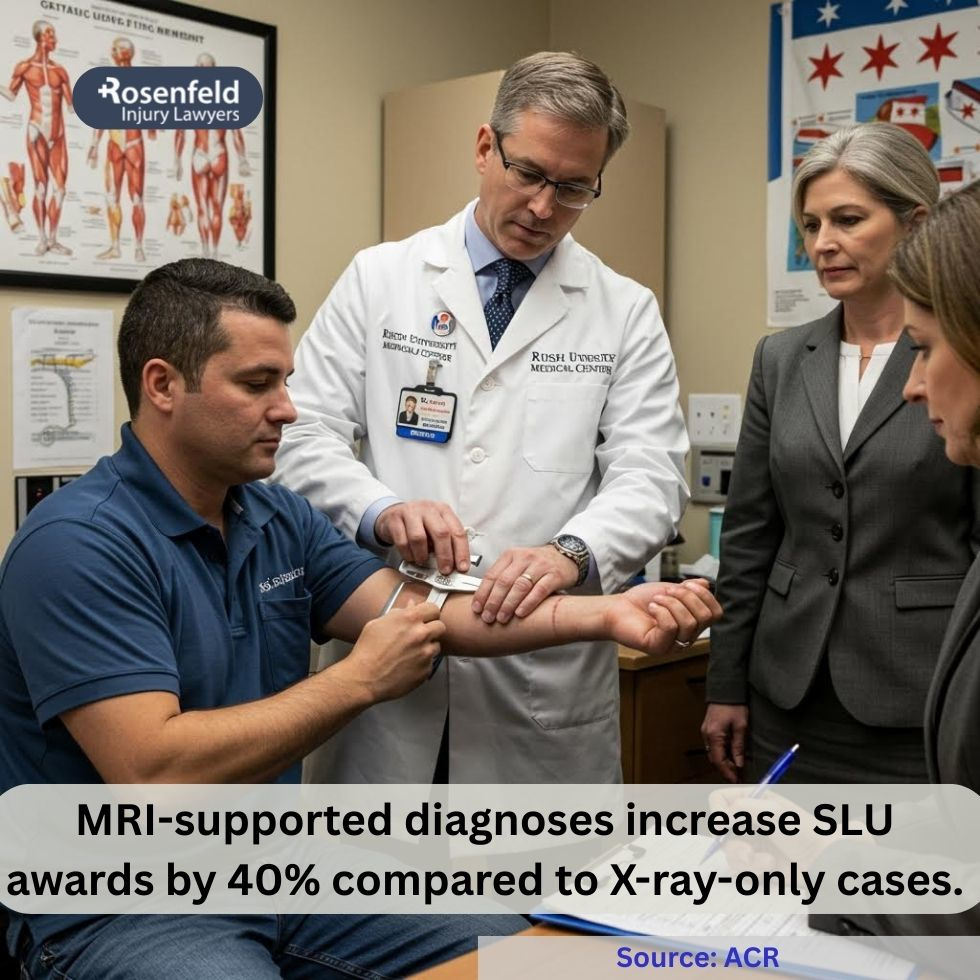- 24/7 Free Consultation: (888) 424-5757 Tap Here To Call Us
Scheduled Loss of Use in Illinois
Scheduled loss of use is an important concept in workers’ compensation claims, as it determines what type of settlement you may receive. If your body part is included under this subset of workers’ compensation law, contact our experienced workers’ comp attorneys for assistance with the claims process. We offer free consultations and work on a contingency fee basis.
What is Scheduled Loss of Use?
This type of workers’ comp is a cash benefit for the permanent loss or permanent functional impairment of a body part. This could mean a permanent disability like paraplegia, vision or hearing loss, or amputation.
How Scheduled Loss of Use Differs from Other Workers’ Compensation Benefits
Scheduled loss of use, also known as an SLU award, differs from other workers’ comp benefits because it is paid out based on injuries to a specific body part. Other types of compensation are calculated based on wage loss and medical costs, not the particular nature of the work-related injury.

The Illinois Workers’ Compensation Act and Scheduled Injuries
Under the Illinois Workers’ Compensation Act, companies are required to carry insurance. Any employee can collect benefits for a work-related accident, even if it was their fault (820 ILCS §305/1). In general, this entitles injured workers to two-thirds of the current average weekly wage as well as full medical benefits.
However, those who have lost functional use of a body part may be awarded different benefits, called scheduled loss of use.
Section 8(e) of the Illinois Workers’ Compensation Act
Section 8(e) of the Illinois Workers’ Compensation Act explains which injuries are subject to SLU awards (820 ILCS §305/8). The worker will receive benefits for a certain period of time, much like if they were totally disabled during that time period. The amount of time will vary depending on which body part was injured.
The Purpose of Scheduled Loss of Use Awards
Certain injuries can lead to a permanent loss of wage-earning capacity, such as injuries to the hands or feet. Because of this, permanently injured workers are entitled to additional cash benefits beyond the average weekly wage and medical expenses provided by normal workers’ comp benefits.
Permanent Partial Disability (PPD) and Scheduled Loss
Scheduled losses are a subset of permanent partial disability payments, which acknowledge a person’s reduced wage-earning capacity after a serious injury. While PPD helps compensate for overall diminished wages or job retraining, scheduled loss specifically reimburses the employee for diminished function or permanent loss of a body part.
Employer Liability for Scheduled Injuries
Workers’ compensation benefits are a no-fault system, meaning that the employer must ensure benefits are fully paid even if the accident was the employee’s fault.
Body Parts Covered Under the Illinois Scheduled Loss of Use Schedule
Current permanent impairment guidelines include the following body parts under scheduled losses. Each type of injury is eligible for a different number of weekly benefits.
- Disfigurement: 162 weeks
- Thumb: 76 weeks
- Index Finger: 43 weeks
- Middle Finger: 38 weeks
- Ring Finger: 27 weeks
- Little Finger: 22 weeks
- Big Toe: 38 weeks
- Other Toes: 12 weeks
- Hand: 205 weeks
- Carpal Tunnel: 28.5 to 57 weeks, depending on severity
- Arm: 253 weeks
- Amputation Above Elbow: 270 weeks
- Amputation at Shoulder Joint: 323 weeks
- Foot: 167 weeks
- Leg: 215 weeks
- Amputation Above Knee: 242 weeks
- Amputation at Hip Joint: 296 weeks
- Vision Loss: 162 weeks
- Loss of Eye: 173 weeks
- Hearing Loss in One Ear: 54 weeks
- Hearing Loss in Both Ears: 215 weeks
- One Testicle: 54 weeks
- Both Testicles: 162 weeks

Calculating Scheduled Loss of Use Awards in Illinois
After you have reached maximum medical improvement, the workers’ compensation board will calculate how much you can receive for your injuries. This is based on both how severe your injury is and how many weeks of compensation you are entitled to under the schedule.
The Statutory Formula: Weeks of Compensation x Percentage of Loss
The basic formula is that you will receive a certain length of benefits at 60% of the statewide average weekly wage (SAWW). This is then multiplied by your percentage loss.
Determining the Number of Weeks for Each Body Part
As noted above, the schedule assigns a certain number of weeks to each body part. For example, if you had to have your arm amputated above the elbow, the maximum number of weeks you could claim benefits would be 270 weeks.
Assessing the Percentage of Loss of Use
In general, the Illinois workers’ compensation board will wait until you have reached maximum medical improvement (MMI) to determine what benefits you are entitled to. An independent medical examiner, typically a doctor or specialist, will perform a full examination and determine the percentage of loss.
As an example, assume the blood vessels and nerves in your arm were compromised by a crush injury, resulting in impaired function in your fingers and other tissues. They may determine that you have only lost 30% functionality. They would then offer their medical opinion to the compensation board.
Permanent Partial Disability (PPD) Rate
SLU awards are based on the PPD rate, which is 60% of the Statewide Average Weekly Wage (SAWW). Currently, that is set at $1,045.92.
Examples of Scheduled Loss Calculations
Here are some examples of what you may receive based on the types of injuries.
- Amputation at Hip Joint: The SLU percentage would be 100%, and you could receive up to $309,592.32.
- Partial Loss of Use of Arm: After you have reached MMI, a doctor determines that your SLU percentage is 40%. You could receive up to $105,847.10.
Medical Evidence in Scheduled Loss of Use Claims
Medical reports are crucial to supporting your case. Our attorneys will gather your records and schedule independent assessments of your functionality, which can be used to demonstrate that you are eligible for full disability benefits. Through our contacts, we can help you find trusted medical professionals at establishments like Northwestern Memorial Hospital who can help validate your claim.
Disputes and Appeals in Scheduled Loss of Use Cases
If the insurance company denies your claim or the company believes that your loss of wage-earning capacity was miscalculated, you can take the case to court. The Illinois Workers’ Compensation Commission Division of the Illinois Appellate Court will assess your case, following requirements like medical assessments of maximum medical improvement (MMI) and percentage of impairment.
Our attorneys will help you prepare your case, including gathering evidence like medical records, expert testimony, and workers’ compensation requirements.

Other Benefits to Consider in Addition to a Scheduled Loss Award
The Illinois Supreme Court case Beelman Trucking v. Illinois Workers’ Compensation Commission affirmed that workers can receive a scheduled loss of use award in addition to other benefits, such as permanent partial disability or total permanent disability.
A PPD award can provide benefits such as occupational therapy, physical rehabilitation, and job training to help you find a new occupation. This would be in addition to medical expenses and lost wages related to your specific injury.
With any of these awards, you can choose between a lump sum payment or a structured settlement. Our attorneys can advise you on which would be the best choice for your needs and ensure that your settlement is legally sound.
It is important to note that once you sign a settlement agreement, you cannot renegotiate it, even if you later suffer further impairments. This is why it is important to ensure you have reached maximum medical improvement before beginning to negotiate for an SLU award.
Why You Need an Experienced Illinois Workers’ Compensation Attorney
As workers’ compensation attorneys, our job is to protect your legal rights and ensure that you get the highest possible compensation. Insurance companies do not want to pay your benefits, so they will play games like demanding additional documentation or insisting that you are not as injured as you claim.
We are your advocates, ensuring that other parties fulfill their legal obligations. We can also help investigate your case, supporting your claim with medical evidence.
If a third party, such as an independent contractor or property owner, was responsible for your injuries, we can also pursue a personal injury lawsuit against them. We will use relevant ordinances and statutes to demonstrate their negligence, such as a property owner’s obligation to protect all workers against fires or flammable liquids (14B-33-3314).
Contact a Workers’ Comp Attorney Now!

If you’ve been injured at work, Rosenfeld Injury Lawyers are here to help. We work on a contingency fee basis, meaning that you owe us nothing unless we earn you a settlement. With our 98% success rate and thousands of satisfied clients, you can be assured of the best possible chance at fair compensation.
Schedule a free consultation with a Chicago personal injury attorney today by calling (888) 424-5757 or using our online contact form.
All content undergoes thorough legal review by experienced attorneys, including Jonathan Rosenfeld. With 25 years of experience in personal injury law and over 100 years of combined legal expertise within our team, we ensure that every article is legally accurate, compliant, and reflects current legal standards.







